Vriezia: varieties and care recommendations

Vriezia is a wonderful unpretentious plant (the most unpretentious bromeliad), which differs in that it does not require complex and constant care. However, this does not mean at all that no action is needed for its growth and healthy development. Of course, in a certain way it is necessary to take care of vriezia and it should be done correctly. Even an inexperienced florist who does not have rich knowledge in this matter will be able to grow this gorgeous tropical beauty on his own if he follows a number of important rules.

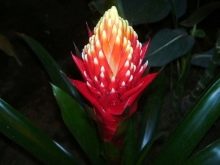

Description
Vriezia is recognized as one of the brightest and most decorative representatives of the bromeliad family. It is a beautiful herb that grows in trees. Vriezia lives in the humid tropics - in South and Central America. If we consider the habitat of this plant more specifically, then you can find out that this includes Brazil, Argentina, and the West Indies.
The main feature of this beautiful plant lies in its amazing spike-shaped inflorescences.that are present directly on the peduncle. Under natural conditions, the latter may well reach one meter. Very original and eye-catching flowers usually have a characteristic yellow or red color. However, sometimes you can meet such specimens in which flowers have a non-standard color - green, white, bright orange. You can even stumble upon multi-colored specimens that never go unnoticed.
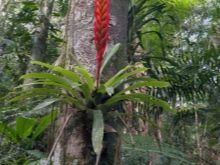

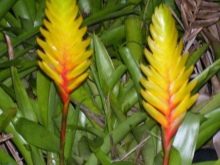
You can admire the bloom of tropical vriezia for a long time - this is another feature of this plant. The bracts of this beauty can last from 4 to 5 months. However, the flowers themselves "show" for only a couple of weeks. Vriezia flower stalks are usually very long. Due to this distinctive feature and the bright color of the bracts, the people call this plant With a "flaming sword".
As for the direct leaf plates of the vriezia, they differ in that they are leathery and belt-like. As a rule, their edges are characterized by a smooth surface, and the shape is usually curved. The color of the foliage here is mostly close to a bright green hue, but some subspecies have characteristic scaly and specks with a contrasting color. Foliage gathers in a kind of funnel. In its central part, moisture accumulates, which is designed to nourish the plant itself.
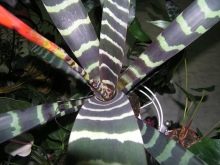
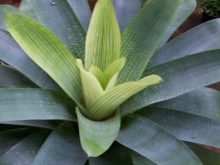

The fruit of this tropical plant itself is a kind of box. Inside it there are seeds with special wings. Outwardly, they are very similar to a crest. After a period of ripening, the fruit simply bursts, and the seeds fly away. Further, vriezia inevitably fades, leaving behind offspring, presented in the form of root rosettes (in other words, children).
Under natural conditions, this a spectacular and bright flower can grow on other sprouts, why rhizomes can only serve for utilitarian purposes. With their help, the flower can be held on the surface of rocks, trees, snags and hemp.
The Vriezia almost lost the function of moisture absorption and absorption of nutrients from the soil.

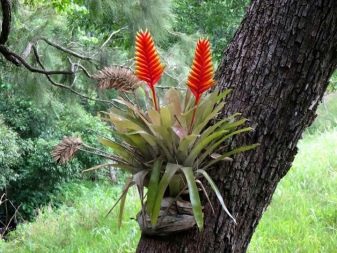
In room conditions, Vriezia feels quite comfortable. That's why it can be safely grown not only in a greenhouse, but also in a simple city apartment. This original plant, despite its homeland, perfectly gets used to dry enough air.
If you create a proper microclimate for Vriezia, it will multiply very actively, delighting with flowering several times a year.
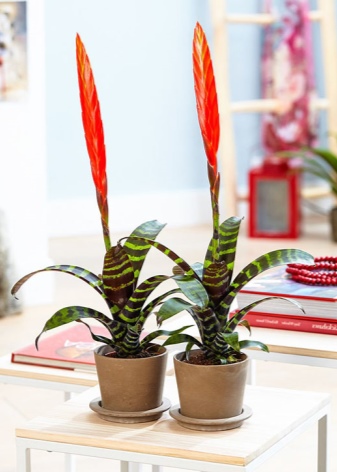
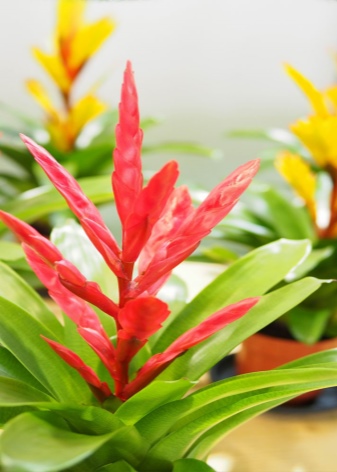
Views
There are several varieties of this bright and original flower. Each of the individual types of vriezia has its own distinctive features and characteristics, which are worth familiarizing with if you plan to plant this flower. Let's take a closer look at the most common options.
"Splenriet"
The wonderful "Splenriet" vriezia is incredibly in demand among flower growers. It is a unique decorative variety. He ideal for indoor cultivation... Vriezia "Splenriet" grows exclusively in the tropical forests of South America.
This creature is characterized by elongated, xiphoid foliage plates with a characteristic light green color and dark marble print... The foliage is usually collected in a kind of funnel-shaped receptacle.
The peduncle of a plant of this variety can reach 40 cm in length. The inflorescences, as a rule, have a deep red color, are paniculate. The flowering period of this flower is in the spring.
If you provide the vriezii of this variety with proper care, then it is quite capable of blooming even in the fall.
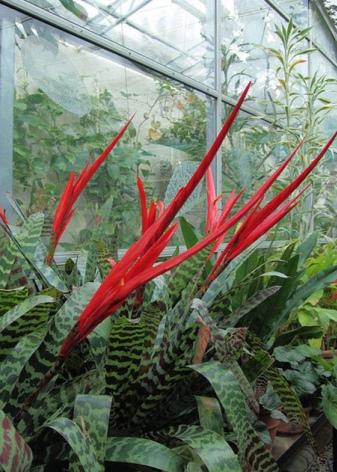
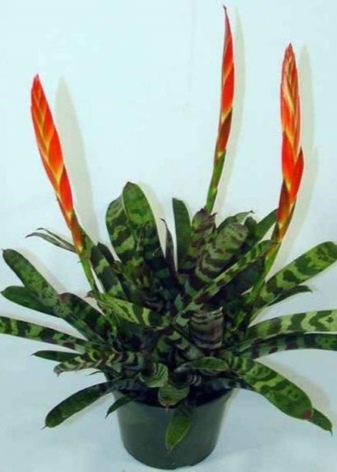
Astrid
This crop variety is positioned as profusely flowering. On one such vrieziya can simultaneously hatch up to 5 peduncles (one meter each). Inflorescences on them usually have a characteristic bright red color. This spectacular flower blooms towards the end of the winter season. Its flowering period continues for a further four months.
The leaf plates usually have a dark green color, glossy texture. Their thickness is rarely great. More often the leaves of this plant are thin and can even curl slightly, creating interesting curls.
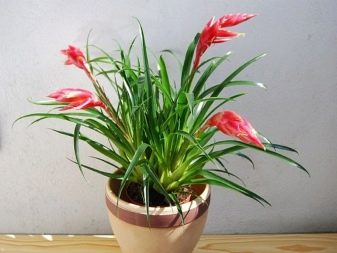
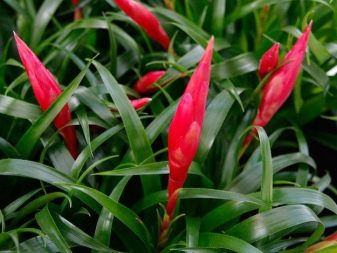
"Davina"
This tropical plant is more compact. It was obtained exclusively due to a fairly long selection. As for the height indicators, this flower can reach up to 30 cm. Its leaf blades are usually distinguished by a leathery surface, a xiphoid shape and a light green color.
The peduncle of the flower "Davina" cannot boast of large sizes, as a rule, it is rather small. It grows from the center of the leaf outlet. The inflorescences of this plant are most often large, flat, and their shade is very bright (as in the “Energy” variety) and is close to yellow-red.
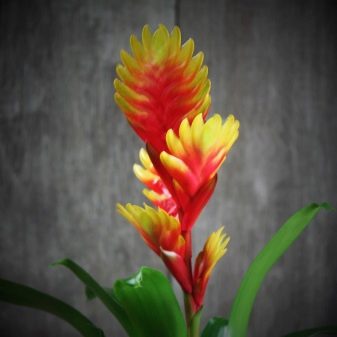
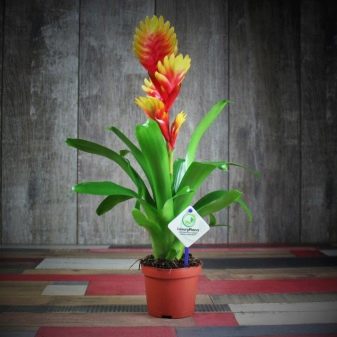
Elan
This variety of Vriezia differs from the above in that has an unusual branched bract... Inflorescences here are often flat, paniculate. Their shade is close to red and the ends are creamy.
The color of the leaves is dark green. Their texture is smooth, and the length is quite large. In addition, the leaf plates of the Elan flower are belt-shaped and form a rosette with a characteristic funnel in the central part.
The described culture is capable of blooming closer to the end of winter or in the spring.


"Era"
This variety of a spectacular tropical flower is usually not too large in size. Lanceolate foliage forms a rosette. Usually, the foliage has a characteristic light green color and is striped - transverse stripes are visible on the plates. The peduncle of this plant may well reach 50 cm. The inflorescences have rich bright red shades.
The strong smell of "Era" vriezia does not come, its aroma is pleasant and barely perceptible. Most often, this culture blooms in the summer season.
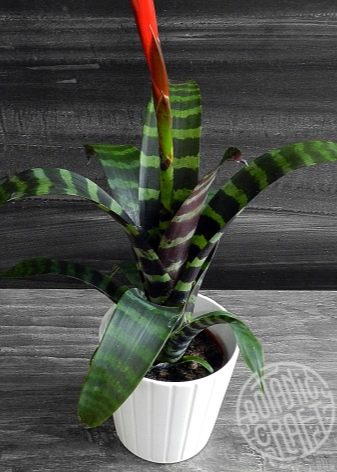
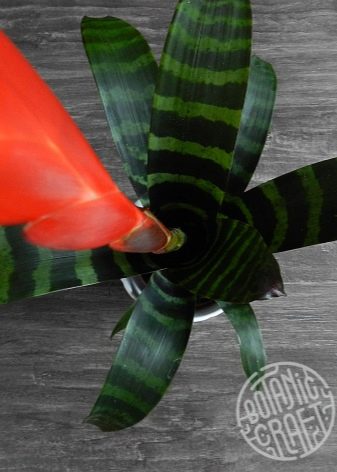
"Stream"
The birthplace of this variety is South or Central America. The leaves of this plant are distinguished by the fact that they grow xiphoid, rather long and tough. Their colors are close to bright green. As in most other cases, the leaves of this vriezia are folded into a rosette with a funnel located in the central part.
It is from the latter that a rather long and branched peduncle eventually grows, having flat paniculate inflorescences of a standard red shade. In most cases, this culture blooms in winter.
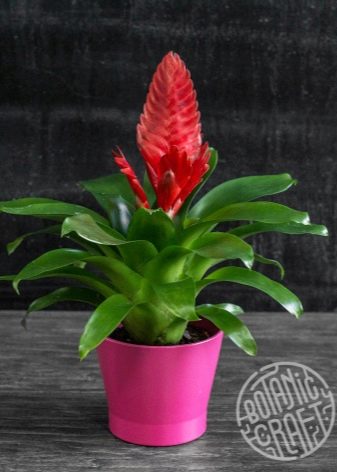
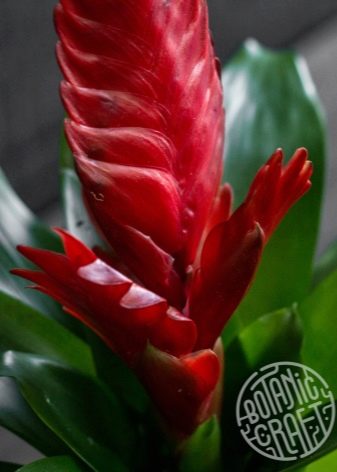
"Splendens" (brilliant vriezia)
The flower of this variety grows in the woods of Venezuela. It is both an epiphyte and a terrestrial plant. The leaves of this plant are lanceolate, long and rosette. Their color is pale green with special marble blotches. The peduncle in length can reach 1 meter.
Inflorescences are usually spike-shaped, with a characteristic yellow or white shade. The flowering of this culture first occurs in February, and the next time in May.
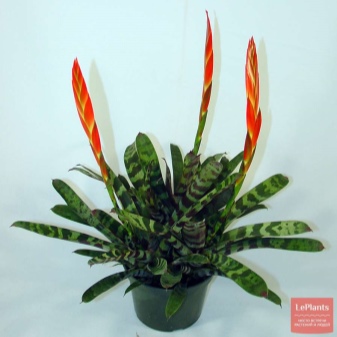

"Style"
Style is a plant that has long, tough leaf blades with a bright green color. In the upper part, the leaves are slightly bent, thus forming a standard rosette with a funnel in the middle. During flowering, in the central part of the rosette, branched peduncle with rich scarlet inflorescencessurrounded by bracts.
It should be borne in mind that the flowers of this plant wither in a short time, they are not enough for a long time. Bracts, on the other hand, are retained for several months, making the plant even more spectacular and beautiful in appearance.
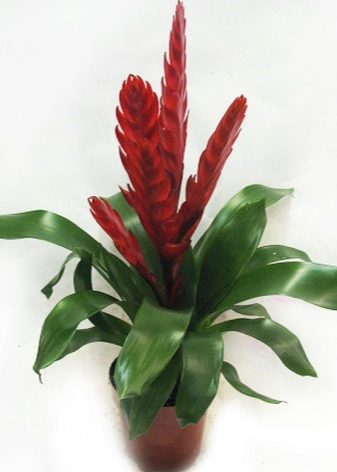
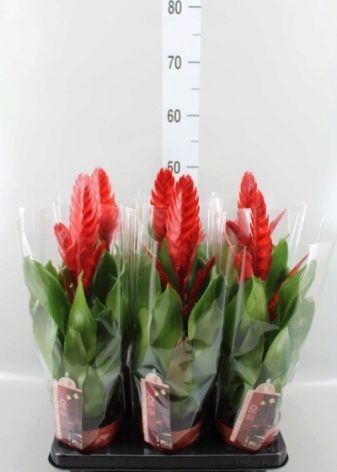
"Mix"
"Mix" is a variety of vriezia, characterized by monochromatic leaves, like a flower of the "Vogue" variety. The latter have a standard bright green color and characteristic gloss. The inflorescences look more like a fluffy bunch of colorful flowers.
Bracts are scaly. The color of these plants is presented in a rich color palette - from yellow to red shades. Such vriezia retains decorative qualities for a long time.
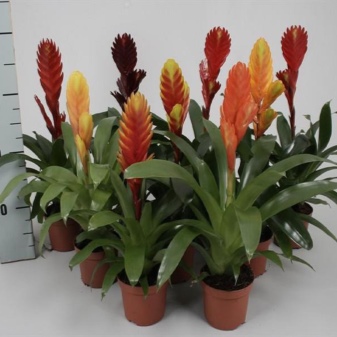

Sanders
A perennial plant that can reach a height of 40 cm. Its stem is short and dense. The leaves are usually gray-green or yellow in color, shine... The lower surface of the leaves is purple in color.
These elements are collected in a basal outlet. The flowers are usually tubular, yellow.


How to plant correctly?
After buying a vriezia, it is imperative to transplant it correctly. To do this, you will first need to correctly select a suitable pot. The vessel must meet the following requirements.
- The height of the container should not be very large - no higher than 15 cm. The top should be wide. The volume should correspond to the size of the root system of the sprout.
- The vessel must attend drainage holes.
- Better to take a ceramic pot... The plastic container can tip over due to the weight of the plant.
- If you bought a plastic pot, then it is advisable to insert it into a ceramic pot for stability.
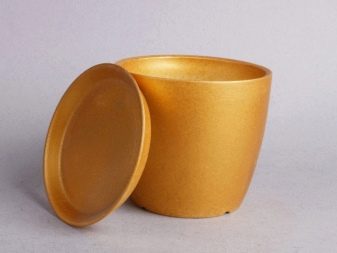
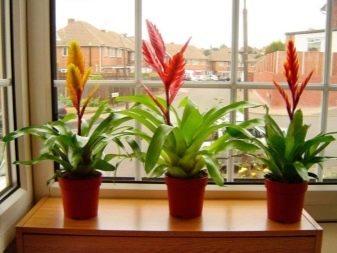
The substrate in which you plan to grow the flower should be loose and nutritious. It is permissible to use a ready-made mixture from the store shelf, intended exclusively for bromeliads. And you can make the substrate yourself. To do this, take the following components:
- sod land - 2 parts;
- special fibrous peat - 1 part;
- sheet land - 1 part;
- coarse sand - 1/3 part;
- small amount of charcoal.
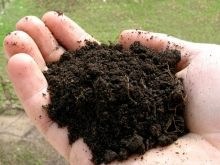


Having prepared all the necessary components, you can proceed to the direct planting of a tropical bright flower. It should be borne in mind that Vriezia itself "does not like" this procedure very much. After it, the plant will not fully develop for a long time. The development of the root system will become noticeably slower, which is why it is customary to plant a ripe flower in a new place no more than once every 3-5 years. A transplant is required in 2 main cases:
- in order to reproduce a flower;
- if you purchased Vriezium in shipping soil.
The acquired plant, if it does not bloom, must go through an adaptation period of about 2 weeks. After that, it can be transplanted, because transport soil is not the best solution for this flower.
Blooming vriezia does not need to be repotted.It is advisable to immediately find a permanent place for her. Wait until the flowering ends and the first babies appear, and then plant them.

It is advisable to transplant Vriezia during active growth, that is, in the spring or at the very beginning of summer. Let's consider step by step how to properly plant a vriezia.
- Fill the purchased pot with drainage (from broken shards and expanded clay) by 1/3. Add charcoal to it, which will prevent the soil from souring.
- Next, fill in a layer of soil. It should take up about the same volume as drainage.
- Remove as carefully as possible vriezia from an old pot. Be careful not to damage the roots. Place the flower in a new container.
- Set plant in a new place and fill it with soil.
- So that the soil crumbles correctly, effortlessly tap the pot on the table. When the soil settles, it will be possible to add more.
- You can slightly crush the top soil with your fingers. But you don't need to press hard, so as not to harm the roots.
- Move the plant in a warm place where there are no drafts, but there is enough light. Water the outlet.
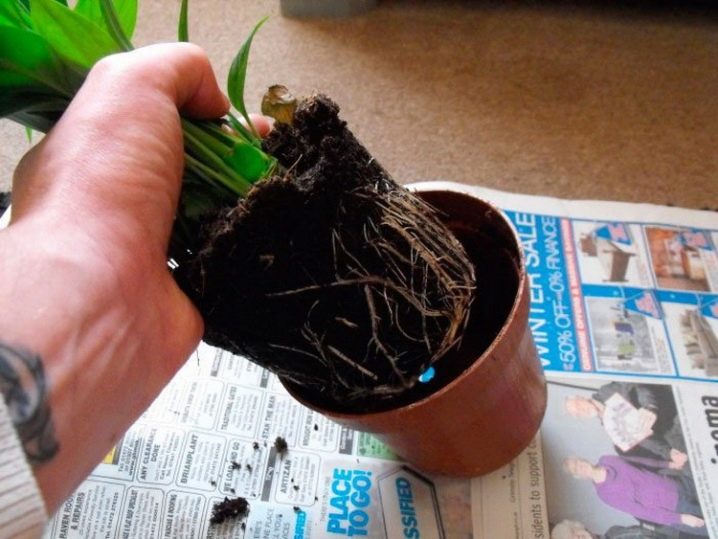
For information on how to transplant Vriezia, see the next video.
Home care
Growing Vrieseia is not the most difficult task. She needs to be looked after taking into account the following recommendations and rules.
- Water the plant regularly. The water level must be constant on the inside of the socket. The soil in the pot must be moist during the summer.
- If a flower has just thrown a peduncle, you no longer need to pour liquid into the outlet. Otherwise, it will simply rot.
- Water at least three times a week. Change the outlet water every three days. Old liquid must be removed with a napkin or cotton wool.
- Watering in winter must be done as rarely as possible. Watering the plant in such conditions will only be required at the moment when the topsoil dries up.
- If the room temperature is low enough, no water should remain in the outlet. If the temperature regime is normal, then it is permissible to leave it there for a couple of hours a day, and then remove it.
- For watering you need to take soft water, preferably at room temperature. The liquid can be either settled or rain. In no case should there be lime in it, otherwise it will show through on the foliage.
- If after watering water is collected in the pan, it needs to be poured out.
- Optimum summer temperature - 22-30 degrees, in winter - 18-22 degrees.
- Air humidity should be in the range of 60-70%.


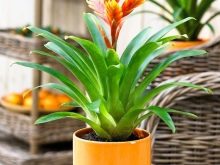
Reproduction
Let's consider step by step how it happens reproduction of vriezia by shoots.
- Mother flower together with the side shoots, you need to carefully and slowly get out of the pot as much as possible. Try not to tear the rhizomes.
- Also carefully remove from the roots remnants of the earth. To do this, it is best to rinse the rhizomes under water.
- Take a sharpened knife. Cut off the shoots from the old planting with them. But do it in such a way that each process has roots, which they can then grow.
- Don't forget to sprinkle cut areas with charcoal.
- Processed shoots must definitely dry out throughout the day.
- In a prepared pot backfill drainage and soil layer.
- Lock the side escape in the center of the prepared base, and then add the remaining necessary part of the soil.

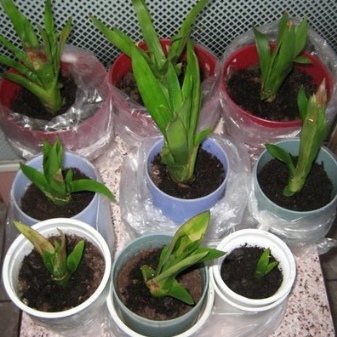
Please note: a freshly planted shoot of this tropical plant requires heat, so it is recommended to cover the pot with it with a small greenhouse or a glass jar. The temperature should be kept within the range of 26-28 degrees. A month later, it is permissible to resort to small ventilation. Gradually, the residence time of the flower outside the greenhouse will need to be carefully increased.
It will be possible to start transplanting a young plant no earlier than in a year. Young vriezias should be looked after in the same way as adults.
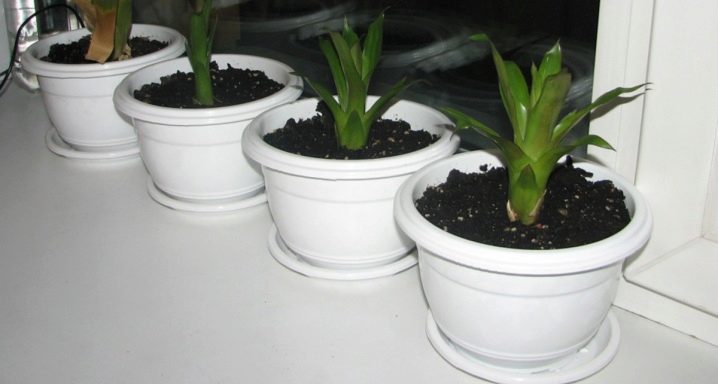
Common mistakes
Consider what common mistakes florists make when growing this flower.
- Insufficient watering. Because of this, the leaves begin to dry. To avoid such problems, Vriezia must be watered regularly. There should almost always be water in the leaf funnel.
- The flower has little light, moisture and heat. Because of this, the flowering of the plant does not occur. Place the vriezia pot in a warm and well-lit place. Don't forget to water it.
- Sunburn. Then brownish spots appear on the leaves. Protect the plant from direct sunlight by covering the window with a curtain or moving the flower to a more suitable location.
- Liquid has stagnated in the sump or funnel. Then the leaves may start to rot. Remember to remove excess moisture. Do not fill the flower unnecessarily.
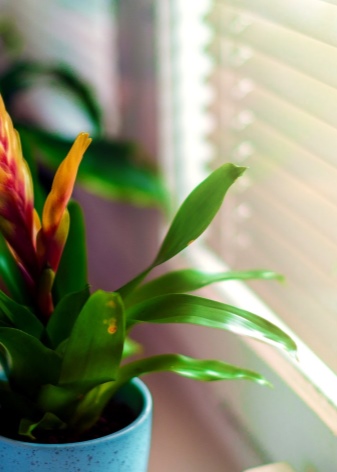
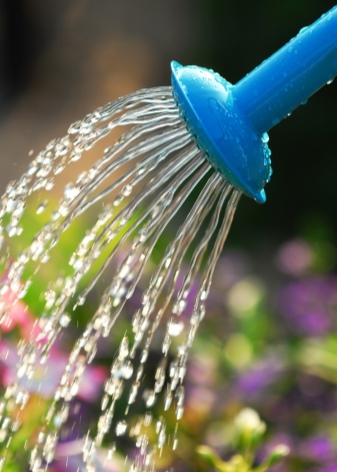
Diseases and pests
Like any other plant, Vriezia is susceptible to a number of serious diseases and attacks by certain parasites. Let's get acquainted with their list.
- Shield aphid. If attacked by this parasite, brownish bumps form on the leaves. The plates become sluggish. It is necessary to wipe the foliage with a cloth dampened with soapy water. If there are too many scale insects, the flower should be treated with insecticides.
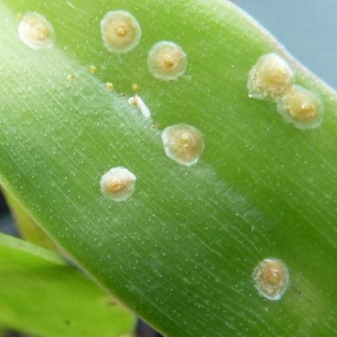
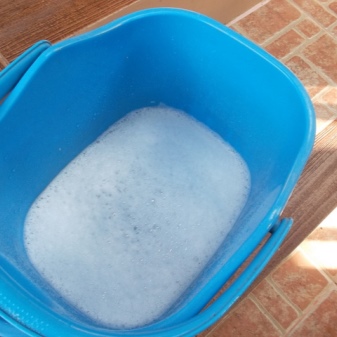
- Root worm. Oviposition is observed at the neck of the rhizomes. The pest devours the roots, and then the leaves rot. If such a problem occurs, care must be taken to avoid excessive moisture. When a parasite appears, immediately treat the flower with Karbofos.
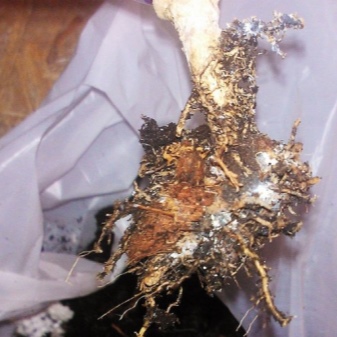
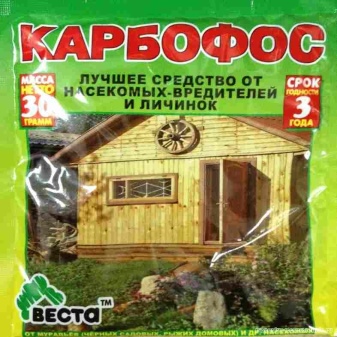
- Mealybug. White lumps form in the axil of the leaves. The leaves are deformed. Treat the flower with a solution of Aktara or Fitoverm. After a week, repeat the procedure.
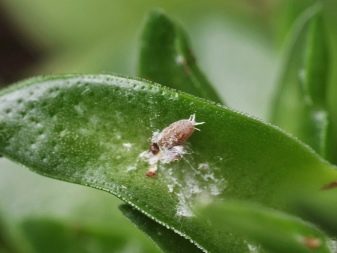
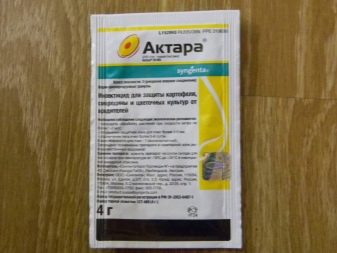
- Red spider mite. A spider web with white dots appears on the foliage. In such cases, the plant must be provided with a warm shower - thoroughly wash off the pests. Treat with Actellic or Decis.
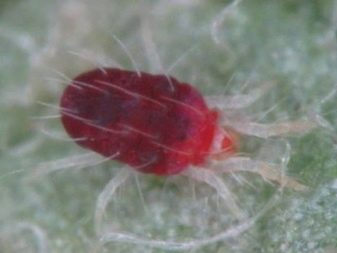
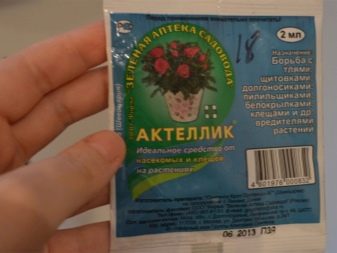
- Spotting. If this serious ailment occurs, then noticeable transparent small blisters will appear on the leaves of the plant. A little later, gray stripes can be seen on the sheet plate. To solve this problem, you need to understand the watering regime of the flower. Spray the foliage on both sides, as well as the soil with a fungicide.
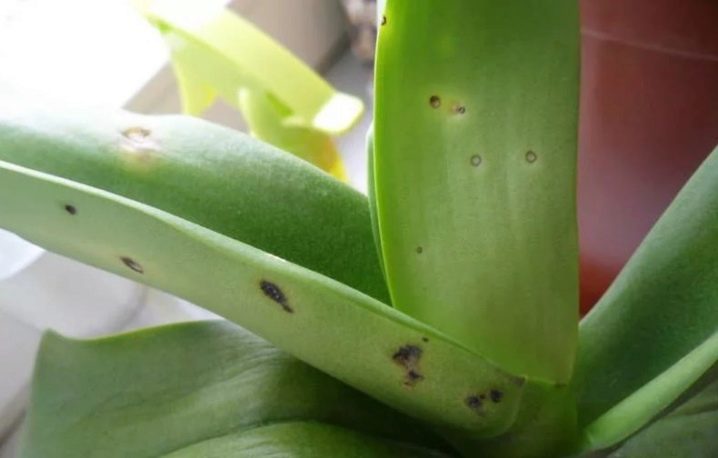
Learn more about Vrieseia care in the video below.























The comment was sent successfully.